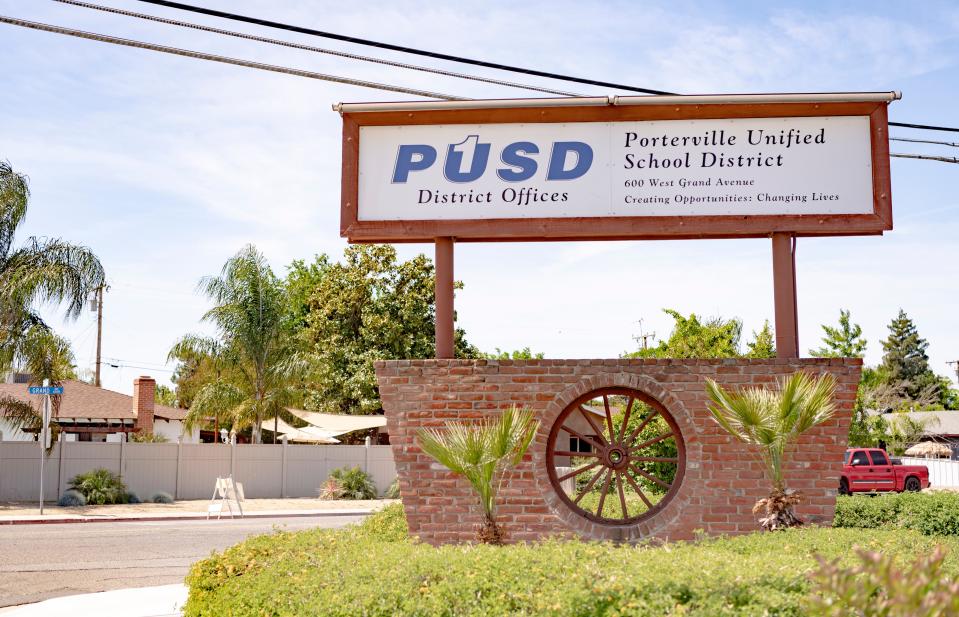Tulare County school district awarded grant funding to protect students from extreme heat
- Oops!Something went wrong.Please try again later.
Extreme heat is deadly.
There were 5% more deaths during the record heatwave last September than would be expected in normal summer conditions, according to a report by the California Department of Public Health.
To protect California's children against extreme heat, Gov. Gavin Newsom announced another $73 million from Cal Fire for schools to replace asphalt with green spaces, trees and vegetation to provide shade. This allotment adds to the $47 million that was announced in July.
One of the school districts awarded grant funding is Porterville Unified School District. The district is home to more than 14,000 students, in a Tulare County community that faces "sizable and interrelated health, environmental, and economic challenges," state officials said.
The Green Schoolyard Grant program is part of the governor’s Extreme Heat Action Plan, which is backed by the $52.3 billion California Climate Commitment budget.

Spaces for students to 'thrive and enjoy'
Porterville Unified School District, in partnership with the Climate Action Pathways for Schools, will complete high-impact green campus projects at five elementary sites.
“The grant provides needed shaded space for outdoor learning and will encourage movement and exercise to advance our students health and wellbeing," Superintendent Nate Nelson said. "Each school will be thrilled to have tree-shading and beautiful spaces for our students to thrive and enjoy.”
The five Porterville schools are:
West Putnam Elementary School
Belleview Elementary School
Olive Street Elementary School
Santa Fe Elementary School
Doyle Elementary School
The projects include developing tree-shaded pathways, drought-tolerant landscaping, and exercise and play areas for the children, including filtered water hydration stations on each campus. The projects will improve air quality, increase biodiversity, and help protect students from exposure to extreme heat, district officials stated.
The average summer temperature in Tulare County is 101 degrees, according to the National Centers for Environmental Information.
The district will also integrate its career pathways program, providing internships for high school students to help work on the projects.
A mission to create green schoolyards in the Golden State
California’s public school grounds cover nearly 130,000 acres and play a major role in the lives of more than 5.8 million children.
Many campuses are paved and unshaded, leaving many students exposed to extreme heat, said Alejandra Chiesa, California's Green Schoolyards America director.
“We applaud California and CAL FIRE for creating this much needed and unprecedented grant program which will bring nature to school grounds, improving students’ education and mental and physical wellbeing while strengthening their communities’ ecological health and climate resilience,” Chiesa said.
The first round of awards included six implementation projects and nine planning projects on 100 schoolyards statewide.
"Creating schoolyards where children can safely be outside, protected from extreme heat and surrounded by vegetation instead of concrete is something Cal Fire is proud to support, and is something every child should be able to experience at school where they learn and grow," Cal Fire Director Joe Tyler said.
Here’s what else California is doing to keep people safe from extreme heat:
Sharing tips and resources to keep Californians safer. Last month, Newsom launched Heat Ready CA (HeatReadyCA.com), one of the nation’s first statewide multi-lingual awareness and education campaigns designed to keep Californians safe during extreme heat.
Opening cooling centers statewide. Local communities across the state have opened cooling centers in anticipation of extreme temperatures. Newsom and Legislature have advanced community resilience center investments, which can be used to support cooling centers and other resources to protect communities during climate and other emergencies.
Enforcing worker protections. Cal/OSHA is reminding all employers of their legal duty to protect workers from heat illness as a dangerous heat wave is forecast to impact many parts of the state for the next two weeks.
Mobilizing state government. California has activated Phase II of its Extreme Temperature Response Plan, which calls for increased coordination among state agencies and local partners.
This article originally appeared on Victorville Daily Press: Tulare County school district plans to protect students from extreme heat

